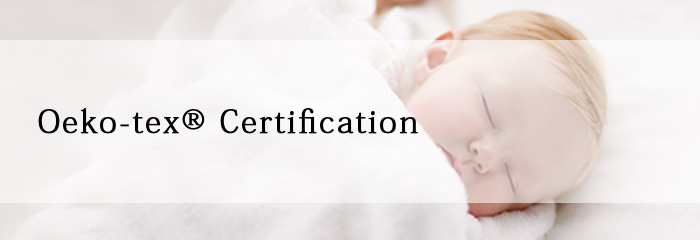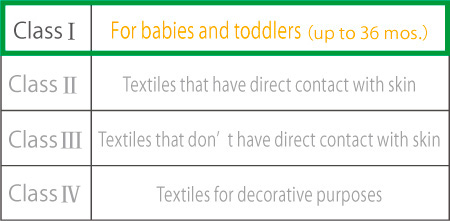
Global standard for safety
About Oeko-tex® Standard 100, Class I Certification
Oeko-tex® Standard 100 is an international safety standard for textile products, established by the international Oeko-tex® Association (based in Switzerland) comprising institutes for research and testing in 24 countries worldwide, especially in Europe.

Application of this standard means to voluntarily restrict hazardous substances that may be found in textiles and to certify safety. Products certified by Oeko-tex® are confirmed to be free of chemicals that are hazardous or possibly hazardous to the human body.
Oeko-tex® Standard 100 certification tests and analyzes products for chemicals that are prohibited/restricted by laws or voluntary restraint around the world and is granted to items that are confirmed to be completely within limits.
Oeko-tex® Standard 100 Product Classes
Oeko-tex® Standards have different restrictions according to four product classes. Class 1 for babies and toddlers is the most stringent.

To acquire Oeko-tex certification, the following are required:
- 1. The pH value is such that will not affect the human body
- 2. Formaldehyde content is within the limits
- 3. Harmful heavy metal content is within the limits
- 4. Residual pesticide content is within the limits
- 5. Harmful phenol content is within the limits
- 6. Phthalate content is within the limits
- 7. Organic tin compound content is within the limits
- 8. Specific aromatic amine content (24 types) is within the limits
- 9. No use of carcinogenic colorants
- 10. No use of allergy-inducing colorants
- 11. Fluorine substance content is within the limits
- 12. Chlorinated benzene and toluene content is within the limits
- 13. Polycyclic aromatic hydrocarbon (24 substances) content is within the limits
- 14. Antibacterial agents, flame retardants are not used (some exceptions)
- 15. No organic solvent or surfactant residue
- 16. Color fastness must be satisfactory
- 17. Saliva fastness must be strong for infant products
- 18. VOC content is within the limits
- 19. Lack of abnormal odors
- 20. No use of asbestos
To acquire certification, representative samples are to be chosen to cover the desired certification range, as well as all production processes, colorants, and finishing agents. These samples will be tested and analyzed according to the items above and must fulfill all standard values of the designated class (product category).
To sustain this certification, raw materials, colorants, pigments must be chosen for testing and analysis to cover all certified products once a year and all standard values must be met.





